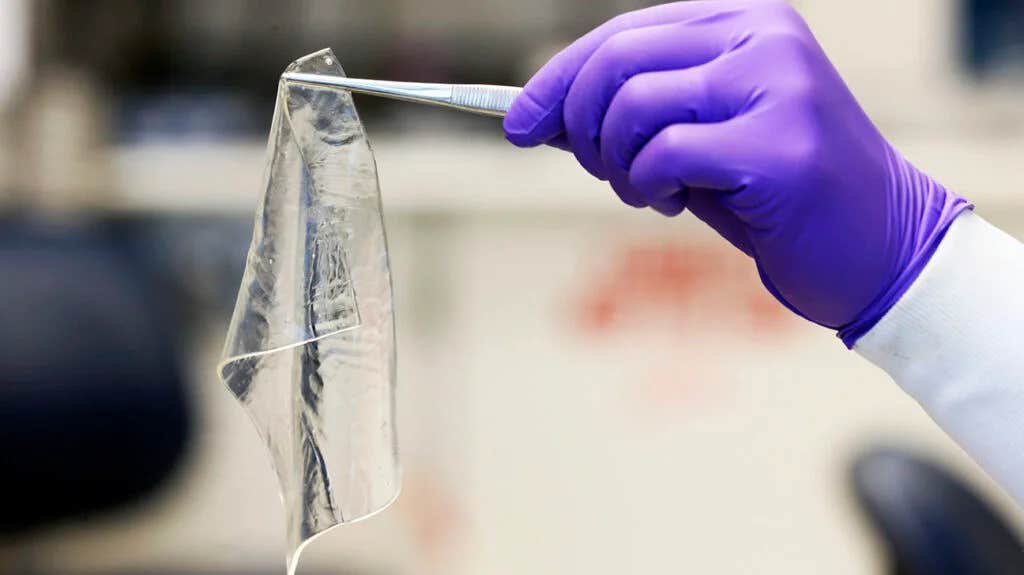New light-activated injectable gel heals bone faster and safer
Scientists have developed a light-activated injectable hydrogel that heals bone defects without the need for grafts or surgery.

A new light-activated injectable hydrogel heals bone defects fast—no grafts needed, just visible light and safe ingredients. (CREDIT: Getty Images)
In today's world, more people suffer from bone problems caused by injuries, infections, or birth defects. As the population grows older, these issues are becoming more common.
Traditional treatments usually involve bone grafts, where doctors use pieces of bone or similar materials to fill damaged areas. Often, they also need to add glue-like substances to hold the pieces in place. But these treatments can be complex, painful, and not always effective.
Injectable hydrogels have become a promising new way to treat bone defects. These soft materials can be pushed into the body through a syringe, filling bone gaps without the need for large surgeries. They are less invasive and simpler to use. But many current hydrogel systems struggle with two major problems. First, they don't stick well to bone tissue under wet conditions. Second, they don't help bones grow back strongly on their own.
A new study has now brought fresh hope. A group of researchers from POSTECH, a leading science and technology university, has created a breakthrough injectable adhesive hydrogel. This special gel can be injected into the body, stick to wet bone surfaces, and help grow new bone—all at the same time.
A New Kind of Healing with Light
What makes this new hydrogel different is how it works. When exposed to visible light, it becomes firm and starts building bone tissue from within. This light is completely safe for the body and works in just a short amount of time. The light does two things at once. First, it causes the gel’s ingredients to stick together tightly. This process is called photocrosslinking. Second, it activates a mineral-building reaction that forms bone-like substances inside the gel.
This is made possible by a smart combination of ingredients. The hydrogel contains alginate, a natural substance found in seaweed. It also includes a protein inspired by mussels—the sea creatures known for their strong grip on rocks.
Scientists added special parts to this protein that allow it to stick better to body tissues, even when wet. Calcium ions and phosphonodiols help trigger bone mineral formation, and a light-sensitive chemical known as a photoinitiator ensures that the process only starts when light is applied.
Related Stories
Together, these elements form a thick liquid that doesn't mix with water. Once injected into the body and exposed to visible light, it hardens quickly and becomes a solid, sponge-like structure. This solid form provides a framework for new bone to grow.
Stronger, Safer, and More Effective
One of the biggest advantages of this hydrogel is how well it sticks. In underwater tests, it showed greater adhesive strength than earlier hydrogels. It also held up better under pressure, meaning it wouldn’t collapse easily inside the body. This strength is important because bones go through a lot of stress and movement. A weak filler would not survive in such an environment.
Also important is the gel's ability to stay in place. Thanks to its unique formulation, it doesn't leak or move after being injected. That’s crucial when dealing with complex or oddly shaped bone defects.
But maybe the most exciting result came from live animal testing. The researchers used a rat model where a hole was made in the femur, the long bone in the leg. They then injected the hydrogel into the damaged area and applied visible light.
The gel stuck perfectly to the irregular bone surface and started helping new bone form. There was no need to add any extra bone graft materials. Within a short period, the defect began to heal, and new bone filled in the gap.
This means the hydrogel not only stays in place and sticks well, but it also creates the ideal conditions for bone cells to grow and repair damage—without the need for outside bone grafts.
A Game Changer for Bone Repair
The researchers behind this study believe their hydrogel can completely change how bone injuries are treated. Professor Hyung Joon Cha, who led the project, explained, “The injectable hydrogel system for bone regeneration developed by our research team represents an innovative alternative to conventional complex treatments for bone diseases and will greatly advance bone tissue regeneration technology.”
That’s a bold statement, but the facts back it up. This new system avoids the need for multiple steps and materials. It makes the treatment of bone defects simpler, faster, and more reliable. All it takes is one injection and a burst of visible light.
Earlier light-based hydrogels had issues. They often needed bone grafts to be added separately, and the bonding wasn’t strong enough. Over time, the gel would break down or fail to stay in the right place. This new approach overcomes all those problems in a single step.
The research, recently published in Biomaterials, one of the top journals in this field, showcases how advanced science and nature-inspired materials can work together. By combining mussel-like adhesion with seaweed-based gel and bone-forming minerals, the team has created a smart, safe, and powerful tool for healing.
What This Means for the Future
This injectable hydrogel could help doctors treat bone injuries more easily, especially in older patients or those with complex wounds. It might be used in dental surgery, joint repair, or after accidents that leave bones broken in hard-to-reach places.
It also means fewer surgeries, lower costs, and quicker healing times. Because it doesn’t require added bone grafts or extra materials, it simplifies the work for surgeons and reduces the risks for patients.
Though the research is still in its early stages, its success in lab and animal studies shows strong promise. With further testing and approval, this hydrogel might soon move from the lab to hospitals.
Scientists will continue to improve the formula, test it on larger animals, and work toward human trials. But for now, it marks an exciting step forward in solving one of medicine’s toughest challenges—how to regrow bone in a safe, simple, and strong way.
Note: The article above provided above by The Brighter Side of News.
Like these kind of feel good stories? Get The Brighter Side of News' newsletter.
Mac Oliveau
Science & Technology Writer | AI and Robotics Reporter
Mac Oliveau is a Los Angeles–based science and technology journalist for The Brighter Side of News, an online publication focused on uplifting, transformative stories from around the globe. Passionate about spotlighting groundbreaking discoveries and innovations, Mac covers a broad spectrum of topics—from medical breakthroughs and artificial intelligence to green tech and archeology. With a talent for making complex science clear and compelling, they connect readers to the advancements shaping a brighter, more hopeful future.



